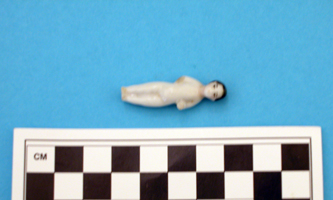Hi! My name is Jessica Yuan, and I’m a sophomore who is about to declare a major in Cultural and Social Anthropology. After taking an introductory course to archaeology last quarter, I was itching to put my new theoretical knowledge on archeological concepts and techniques to use. When the opportunity to enroll in Professor Voss’ class on laboratory methodology in archaeology arose, I signed up eagerly, knowing it would be the perfect venue for me to explore my interest in archaeology further and gain substantial hands-on experience in analyzing historical artifacts. I have gotten much more than I bargained for: in addition to acquiring skills in the identification, analysis, and cataloging of a wide array of materials, ranging from ceramics to lithics, I have also learned much on the history of overseas Chinese in the San Jose area. As my own family’s legacy is one of immigration from China to California, I found much of the contextual information of the Market Street Artifact Collection especially relevant to my understanding of my own family heritage.
This past week marked the eighth that our class has spent with the Market Street Chinatown Artifact Collection, and we are becoming more and more adept at classifying different archaeological materials. Our focus this week has been on recognizing faunal and floral remains and drawing various analyses and interpretations from them. As a class, we got an opportunity to try our hand at zooarchaeology, learning some of the fundamentals of skeletal anatomy and bone structure, in addition to different methods of collecting descriptive, primary data and interpretive, secondary data. We learned how through studying weathering and abrasion patterns or calculating MNI (Minimum Number of Individuals) values, archaeologists can make inferences about ages, genders, and frequencies of various animals, which allow for interpretations into patterns of culture and activity of the past. Following a lecture on Tuesday, the class spent Thursday in a practicum setting, examining botanical and faunal materials. By studying seeds and various fragments of bone and shell, we were able to gain some insight into the lifeways of people of the past. Friday was open lab day, in which students each worked on the individual research projects they have been developing throughout the quarter, which address topics as diverse as hygiene practices, conceptions of childhood, and household religious activity in the Market Street Chinatown.
Featured Artifact
With its delicately painted pink cheeks and black hair, this Frozen Charlotte doll that Rachel discovered when searching through a storage box immediately caught my attention. Measuring only 3.73 cm in length, this porcelain doll was one of many mass-produced in Germany between 1860 and 1900. These tiny dolls, which typically ranged in length from one to four inches, were widely popular throughout the United States in the late 19th and early 20th centuries, perhaps because as “penny dolls,” their low price made them well-suited for children’s toy collections. The doll was named after the title character in the William Lorenzo Carter folk ballad “Fair Charlotte,” which sings the tragic story of a beautiful young bride who freezes to death on a winter sleigh ride with her husband after refusing to warm herself with a blanket. The presence of these Frozen Charlottes in the Market Street Chinatown attests not only to the presence of children within the community, but also to a degree of acculturation to Western practices and adoption of Western commodities.


